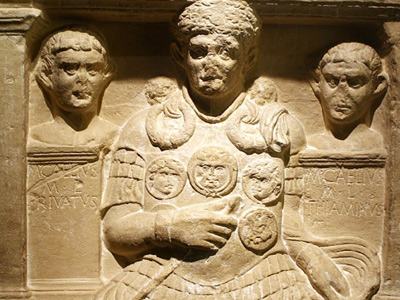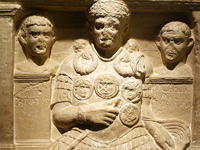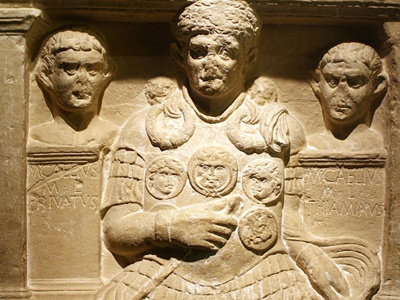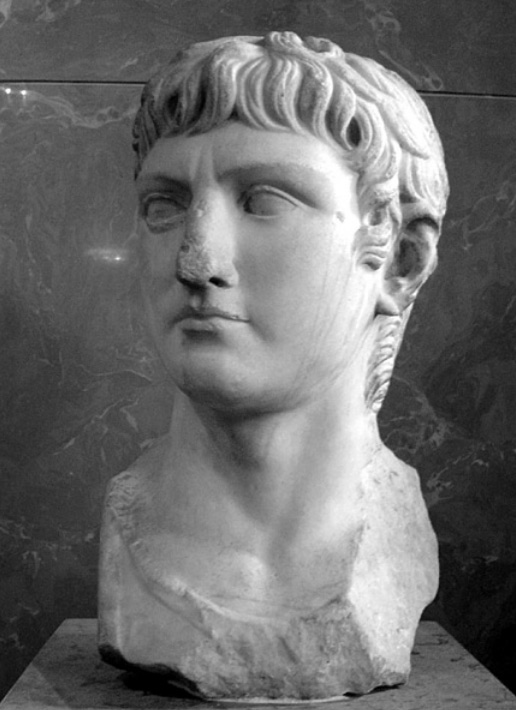Battle of the Teutoburg Forest (9 AD)

Roman Retaliation
Germanicus' Campaign against the Germanic Tribes
Though the shock at the slaughter was enormous, the Romans The Roman Empire was the post-Republican period of ancient Rome. As a polity, it included large territorial holdings around the Mediterranean Sea in Europe, North Africa, and Western Asia, and was ruled by emperors. The first two centuries of the Roman Empire saw a period of unprecedented stability and prosperity known as the Pax Romana ('Roman Peace'). The Empire was later ruled by multiple emperors who shared control over the Western Roman Empire and the Eastern Roman Empire. immediately began a slow, systematic process of preparing for the reconquest of the country. In 14 CE, just after Augustus' death and the accession of his heir and stepson Tiberius, a massive raid was conducted by the new emperor's nephew Germanicus. He attacked the Marsi with the element of surprise. The Bructeri, Tubanti, and Usipeti were roused by the attack and ambushed Germanicus on the way to his winter quarters, but were defeated with heavy losses.
The Roman Empire was the post-Republican period of ancient Rome. As a polity, it included large territorial holdings around the Mediterranean Sea in Europe, North Africa, and Western Asia, and was ruled by emperors. The first two centuries of the Roman Empire saw a period of unprecedented stability and prosperity known as the Pax Romana ('Roman Peace'). The Empire was later ruled by multiple emperors who shared control over the Western Roman Empire and the Eastern Roman Empire. immediately began a slow, systematic process of preparing for the reconquest of the country. In 14 CE, just after Augustus' death and the accession of his heir and stepson Tiberius, a massive raid was conducted by the new emperor's nephew Germanicus. He attacked the Marsi with the element of surprise. The Bructeri, Tubanti, and Usipeti were roused by the attack and ambushed Germanicus on the way to his winter quarters, but were defeated with heavy losses.
The next year was marked by two major campaigns and several smaller battles with a large army estimated at 55,000–70,000 men, backed by naval forces. In spring 15 CE, Legatus Caecina Severus invaded the Marsi a second time with about 25,000–30,000 men, causing great havoc. Meanwhile, Germanicus' troops had built a fort on Mount Taunus from where he marched with about 30,000–35,000 men against the Chatti. Many of the men fled across a river and dispersed themselves in the forests. Germanicus next marched on Mattium (caput gentis) and burned it to the ground. After initial successful skirmishes in summer 15 CE, including the capture of Arminius' wife Thusnelda, the army visited the site of the first battle. According to Tacitus, they found heaps of bleached bones and severed skulls nailed to trees, which they buried, "...looking on all as kinsfolk and of their own blood...". At a location Tacitus calls the pontes longi ("long causeways"), in boggy lowlands somewhere near the Ems, Arminius' troops attacked the Romans. Arminius initially caught Germanicus' cavalry in a trap, inflicting minor casualties, but the Roman infantry reinforced the rout and checked them. The fighting lasted for two days, with neither side achieving a decisive victory. Germanicus' forces withdrew and returned to the Rhine.
Under Germanicus, the Romans marched another army, along with allied Germanic auxiliaries, into Germania in 16 CE. He forced a crossing of the Weser near modern Minden, suffering some losses to a Germanic skirmishing force, and forced Arminius' army to stand in open battle at Idistaviso in the Battle of the Weser River. Germanicus' legions inflicted huge casualties on the Germanic armies while sustaining only minor losses. A final battle was fought at the Angrivarian Wall west of modern Hanover, repeating the pattern of high Germanic fatalities, which forced them to flee beyond the Elbe. Germanicus, having defeated the tribes between the Rhine and the Elbe, then ordered Caius Silius to march against the Chatti with a mixed force of three thousand cavalry and thirty thousand infantry and lay waste to their territory, while he himself, with a larger army, invaded the Marsi for the third time and devastated their land, encountering no resistance.
With his main objectives reached and winter approaching, Germanicus ordered his army back to their winter camps, with the fleet incurring some damage from a storm in the North Sea. After a few more raids across the Rhine, which resulted in the recovery of two of the three legions' eagles lost in 9 CE, Tiberius ordered the Roman forces to halt and withdraw across the Rhine. Germanicus was recalled to Rome and informed by Tiberius that he would be given a triumph and reassigned to a new command.
Germanicus' campaign had been taken to avenge the Teutoburg slaughter and also partially in reaction to indications of mutinous intent amongst his troops. Arminius, who had been considered a very real threat to stability by Rome, was now defeated. Once his Germanic coalition had been broken and honour avenged, the huge cost and risk of keeping the Roman army operating beyond the Rhine was not worth any likely benefit to be gained. Tacitus, with some bitterness, claims that Tiberius' decision to recall Germanicus was driven by his jealousy of the glory Germanicus had acquired, and that an additional campaign the next summer would have concluded the war and facilitated a Roman occupation of territories between the Rhine and the Elbe.
Later Campaigns
The third legionary standard was recovered in 41 CE by Publius Gabinius from the Chauci during the reign of Claudius, brother of Germanicus. Possibly the recovered aquilae were placed within the Temple of Mars Ultor ("Mars the Avenger"), the ruins of which stand today in the Forum of Augustus by the Via dei Fori Imperiali in Rome.
The last chapter was recounted by the historian Tacitus. Around 50 CE, bands of Chatti invaded Roman territory in Germania Superior, possibly an area in Hesse east of the Rhine that the Romans appear to have still held, and began to plunder. The Roman commander, Publius Pomponius Secundus, and a legionary force supported by Roman cavalry recruited auxiliaries from the Vangiones and Nemetes. They attacked the Chatti from both sides and defeated them, and joyfully found and liberated Roman prisoners, including some from Varus' legions who had been held for 40 years.
HISTORY

RESOURCES
This article uses material from the Wikipedia article "Battle of the Teutoburg Forest (9 AD)", which is released under the Creative Commons Attribution-Share-Alike License 3.0.
© Stories Preschool. All Rights Reserved.










